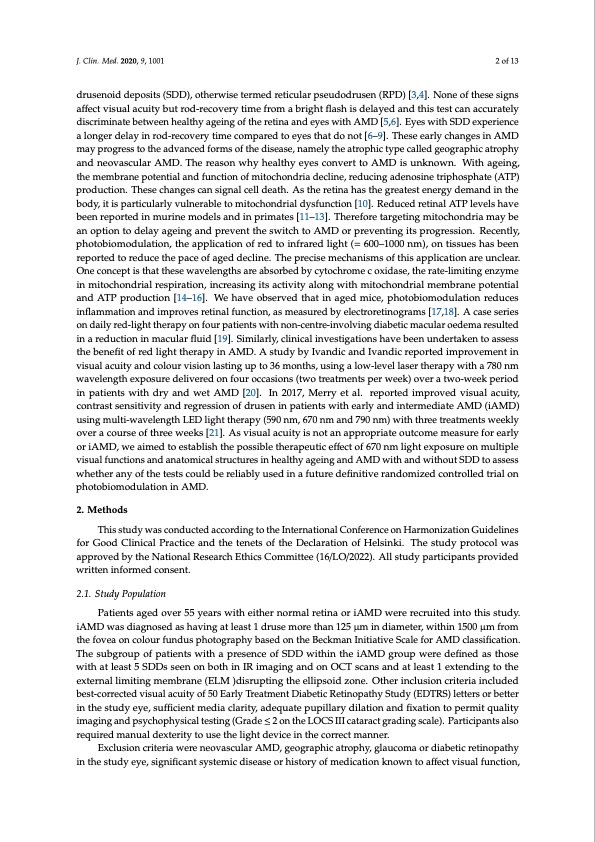
PDF Publication Title:
Text from PDF Page: 002
J. Clin. Med. 2020, 9, 1001 2 of 13 drusenoid deposits (SDD), otherwise termed reticular pseudodrusen (RPD) [3,4]. None of these signs affect visual acuity but rod-recovery time from a bright flash is delayed and this test can accurately discriminate between healthy ageing of the retina and eyes with AMD [5,6]. Eyes with SDD experience a longer delay in rod-recovery time compared to eyes that do not [6–9]. These early changes in AMD may progress to the advanced forms of the disease, namely the atrophic type called geographic atrophy and neovascular AMD. The reason why healthy eyes convert to AMD is unknown. With ageing, the membrane potential and function of mitochondria decline, reducing adenosine triphosphate (ATP) production. These changes can signal cell death. As the retina has the greatest energy demand in the body, it is particularly vulnerable to mitochondrial dysfunction [10]. Reduced retinal ATP levels have been reported in murine models and in primates [11–13]. Therefore targeting mitochondria may be an option to delay ageing and prevent the switch to AMD or preventing its progression. Recently, photobiomodulation, the application of red to infrared light (= 600–1000 nm), on tissues has been reported to reduce the pace of aged decline. The precise mechanisms of this application are unclear. One concept is that these wavelengths are absorbed by cytochrome c oxidase, the rate-limiting enzyme in mitochondrial respiration, increasing its activity along with mitochondrial membrane potential and ATP production [14–16]. We have observed that in aged mice, photobiomodulation reduces inflammation and improves retinal function, as measured by electroretinograms [17,18]. A case series on daily red-light therapy on four patients with non-centre-involving diabetic macular oedema resulted in a reduction in macular fluid [19]. Similarly, clinical investigations have been undertaken to assess the benefit of red light therapy in AMD. A study by Ivandic and Ivandic reported improvement in visual acuity and colour vision lasting up to 36 months, using a low-level laser therapy with a 780 nm wavelength exposure delivered on four occasions (two treatments per week) over a two-week period in patients with dry and wet AMD [20]. In 2017, Merry et al. reported improved visual acuity, contrast sensitivity and regression of drusen in patients with early and intermediate AMD (iAMD) using multi-wavelength LED light therapy (590 nm, 670 nm and 790 nm) with three treatments weekly over a course of three weeks [21]. As visual acuity is not an appropriate outcome measure for early or iAMD, we aimed to establish the possible therapeutic effect of 670 nm light exposure on multiple visual functions and anatomical structures in healthy ageing and AMD with and without SDD to assess whether any of the tests could be reliably used in a future definitive randomized controlled trial on photobiomodulation in AMD. 2. Methods This study was conducted according to the International Conference on Harmonization Guidelines for Good Clinical Practice and the tenets of the Declaration of Helsinki. The study protocol was approved by the National Research Ethics Committee (16/LO/2022). All study participants provided written informed consent. 2.1. Study Population Patients aged over 55 years with either normal retina or iAMD were recruited into this study. iAMD was diagnosed as having at least 1 druse more than 125 μm in diameter, within 1500 μm from the fovea on colour fundus photography based on the Beckman Initiative Scale for AMD classification. The subgroup of patients with a presence of SDD within the iAMD group were defined as those with at least 5 SDDs seen on both in IR imaging and on OCT scans and at least 1 extending to the external limiting membrane (ELM )disrupting the ellipsoid zone. Other inclusion criteria included best-corrected visual acuity of 50 Early Treatment Diabetic Retinopathy Study (EDTRS) letters or better in the study eye, sufficient media clarity, adequate pupillary dilation and fixation to permit quality imaging and psychophysical testing (Grade ≤ 2 on the LOCS III cataract grading scale). Participants also required manual dexterity to use the light device in the correct manner. Exclusion criteria were neovascular AMD, geographic atrophy, glaucoma or diabetic retinopathy in the study eye, significant systemic disease or history of medication known to affect visual function,PDF Image | 670 nm Photobiomodulation in Age-Related Macular Degeneration

PDF Search Title:
670 nm Photobiomodulation in Age-Related Macular DegenerationOriginal File Name Searched:
jcm-09-01001-v2.pdfDIY PDF Search: Google It | Yahoo | Bing
Cruise Ship Reviews | Luxury Resort | Jet | Yacht | and Travel Tech More Info
Cruising Review Topics and Articles More Info
Software based on Filemaker for the travel industry More Info
The Burgenstock Resort: Reviews on CruisingReview website... More Info
Resort Reviews: World Class resorts... More Info
The Riffelalp Resort: Reviews on CruisingReview website... More Info
| CONTACT TEL: 608-238-6001 Email: greg@cruisingreview.com | RSS | AMP |